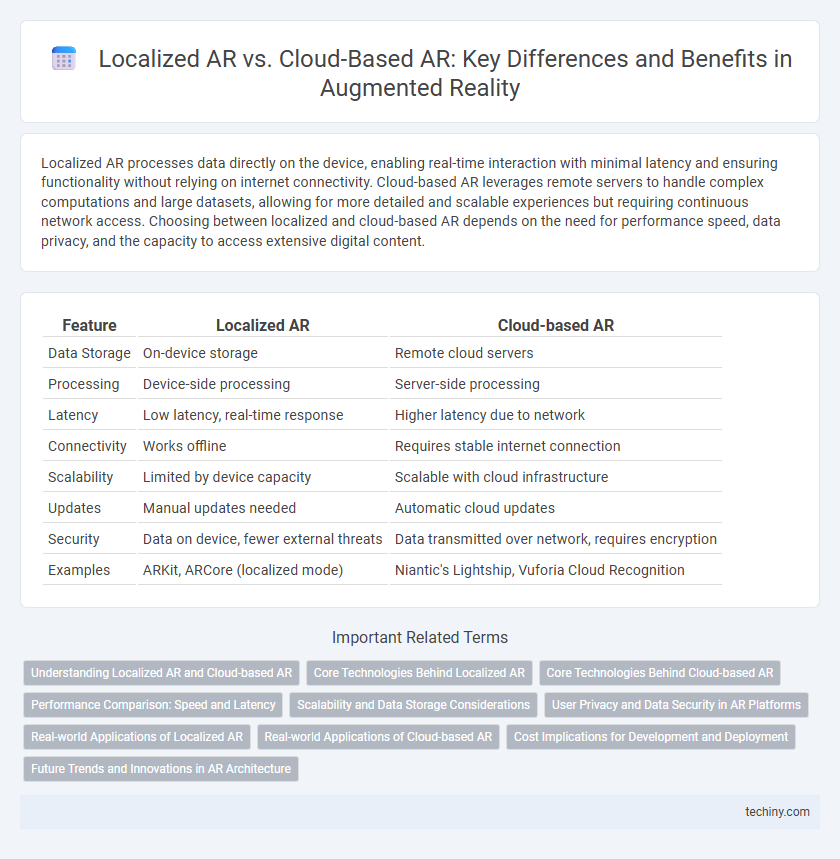Localized AR processes data directly on the device, enabling real-time interaction with minimal latency and ensuring functionality without relying on internet connectivity. Cloud-based AR leverages remote servers to handle complex computations and large datasets, allowing for more detailed and scalable experiences but requiring continuous network access. Choosing between localized and cloud-based AR depends on the need for performance speed, data privacy, and the capacity to access extensive digital content.
Table of Comparison
| Feature | Localized AR | Cloud-based AR |
|---|---|---|
| Data Storage | On-device storage | Remote cloud servers |
| Processing | Device-side processing | Server-side processing |
| Latency | Low latency, real-time response | Higher latency due to network |
| Connectivity | Works offline | Requires stable internet connection |
| Scalability | Limited by device capacity | Scalable with cloud infrastructure |
| Updates | Manual updates needed | Automatic cloud updates |
| Security | Data on device, fewer external threats | Data transmitted over network, requires encryption |
| Examples | ARKit, ARCore (localized mode) | Niantic's Lightship, Vuforia Cloud Recognition |
Understanding Localized AR and Cloud-based AR
Localized AR processes data directly on a device by using onboard sensors and computing power, enabling real-time interaction without relying on an internet connection. Cloud-based AR leverages remote servers to handle complex data processing and storage, facilitating scalable and collaborative experiences with high computational demands. Understanding these distinctions is crucial for selecting the appropriate AR technology based on latency requirements, data privacy, and resource availability.
Core Technologies Behind Localized AR
Localized AR relies on core technologies such as simultaneous localization and mapping (SLAM), computer vision, and depth sensing to create precise spatial tracking and environment mapping directly on the device. These technologies enable real-time tracking and anchoring of virtual objects to physical spaces without continuous internet dependency. Advanced algorithms process sensor data locally, resulting in low latency and stable augmented content aligned with the user's surroundings.
Core Technologies Behind Cloud-based AR
Cloud-based AR relies on technologies like edge computing, 5G connectivity, and AI-driven spatial mapping to deliver seamless, real-time augmented experiences. These core technologies enable complex data processing and storage on remote servers, reducing device load and enhancing scalability. Network infrastructure and cloud platforms such as AWS, Azure, and Google Cloud support dynamic content delivery and multi-user interactions critical to cloud-based AR applications.
Performance Comparison: Speed and Latency
Localized AR processes data on the user's device, resulting in faster response times and minimal latency, essential for real-time interactions and seamless user experiences. Cloud-based AR relies on remote servers for data processing, which can introduce latency due to network delays, impacting the speed and fluidity of AR content rendering. Evaluating performance, localized AR excels in immediate reaction and low-latency applications, while cloud-based AR offers scalability at the expense of potential speed reductions.
Scalability and Data Storage Considerations
Localized AR systems offer faster response times and enhanced privacy by processing data on-device, but they face limitations in scalability due to constrained storage and computational resources. Cloud-based AR enables extensive scalability by leveraging centralized data storage and powerful servers, supporting large user bases and complex content but may introduce latency and depend on reliable network connectivity. Choosing between localized and cloud-based AR involves balancing the need for scalability with data storage capacities and real-time performance requirements.
User Privacy and Data Security in AR Platforms
Localized AR processes data directly on the user's device, minimizing data transmission and significantly enhancing user privacy by reducing exposure to external servers. Cloud-based AR relies on remote servers for data storage and processing, which increases potential risks of data breaches and unauthorized access to sensitive information. Implementing robust encryption and stringent access controls is essential in both approaches to safeguard user data and maintain secure AR experiences.
Real-world Applications of Localized AR
Localized AR delivers precise spatial mapping and real-time interaction by processing data directly on devices, enabling applications in indoor navigation, industrial maintenance, and retail experiences. It enhances user privacy and reduces latency compared to cloud-based AR by eliminating the need for constant internet connectivity. Key real-world implementations include augmented manufacturing workflows, museum tours with detailed artifact AR overlays, and immersive training simulations in healthcare and aviation.
Real-world Applications of Cloud-based AR
Cloud-based AR enables real-world applications such as remote collaboration in manufacturing, where multiple users interact with 3D models in real time from different locations, enhancing precision and reducing errors. It supports large-scale retail experiences by overlaying product information and interactive content on store shelves through smartphones or AR glasses. Urban planning utilizes cloud-based AR to visualize infrastructure projects on-site, integrating live data streams for informed decision-making and stakeholder engagement.
Cost Implications for Development and Deployment
Localized AR demands higher upfront costs due to the need for on-device processing power, advanced sensors, and storage capabilities, which can increase hardware expenses and development complexities. Cloud-based AR reduces initial investment by offloading data processing and storage to remote servers, but ongoing costs include server maintenance, data transmission, and subscription fees. Budget allocation must consider long-term operational costs for cloud connectivity versus the capital expenditure of localized infrastructure.
Future Trends and Innovations in AR Architecture
Localized AR leverages on-device processing to deliver low-latency, high-precision experiences critical for real-time interaction, making it ideal for applications where immediate response and privacy are paramount. Cloud-based AR offloads computation to powerful remote servers, enabling large-scale data storage, advanced AI-driven analytics, and seamless multi-user collaboration, which supports complex and data-intensive AR scenarios. Future trends in AR architecture emphasize hybrid models combining localized edge computing with cloud integration to optimize performance, scalability, and persistent content delivery across diverse environments.
Localized AR vs Cloud-based AR Infographic

 techiny.com
techiny.com